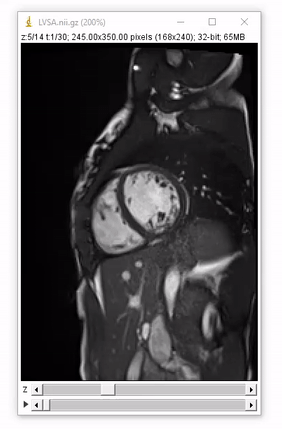Software tools for preprocessing of cardiac MR DICOM datasets and conversion to NIfTI prior to segmentation. You should make a copy of your original data before running this tool.
The files in this repository are organised as follows:
Code: 1) repeated_slices.py (optional) – it identifies repeated cine slices, finds the latest repeat and deletes older versions. 2) auto_conversion.py – converts multi and single frame dicoms into one NIfTI (LVSA.nii.gz). It also identifies the end-diastolic and end-systolic frames in this cine and saves these as separate files (LVSA_img_ED.nii.g and LVSA_img_ES.nii.gz). 3) LVSA_structure.py (optional) – creates a new folder - LVSA – which contains copies of the 3 new NIfTI files.
Data:
Contains sample DICOM datasets on which the functions of the code can be run. LVSA_1 is a Philips sequence with consecutive DICOM files, while LVSA_2 is a Siemens sequence with each slice in separate folders.
To run the code we provide a Docker image with all the necessary dependencies pre-compiled.
A Docker image is available on dockerhub https://hub.docker.com/r/gdoumou/auto_conversion. This image contains a base Ubuntu linux operating system image set up with all the libraries required to run the code.
Click the Code button, and then unzip the file to your desktop etc. In ...CardioNIfTI/data unzip the two folders containing sample DICOM stacks.
For Windows 10 Pro first install Docker. Windows 10 Home users will require Docker toolbox.
Ensure you have the C drive selected as a shared drive in Docker settings (or in VirtualBox on W10 Home).
To visualise the images download ImageJ or equivalent.
In W10 open PowerShell from the Windows search box (Win + X then I), in macOS navigate Finder > Applications > Utilities > Terminal, or in Linux any terminal can be used. Then download the pre-compiled image:
docker pull gdoumou/auto_conversion:latest
Check the image is there
docker images
should show auto_conversion on the list of images on your local system.
Note the path to the data folder (containing the DICOM files) on your desktop eg /c/Users/Desktop/CardioNIfTI/data and substitute <folder-path> within this command:
docker run -it --rm -v <folder-path>:/code/data gdoumou/auto_conversion
At the root prompt enter:
export LD_LIBRARY_PATH=/lib64
Navigate to /code/data and check that it has mounted your DICOM folders (eg LVSA_1 and LVSA_2):
cd data
ls
Then return to /code:
cd ..
1) repeated_slices.py (optional) 2) auto_conversion.py 3) LVSA_structure.py (optional)
example:
python auto_conversion.py
when you finish type:
exit
Once the pipeline is finished, under the root directory of each subject, you have three NIfTI files, i.e., LVSA.nii.gz, LVSA_img_ED.nii.gz and LVSA_img_ES.nii.gz which can be visualised in ImageJ.
This code was developed by Georgia Doumou with help from Wenjia Bai and Jinming Duan - Imperial College London. Dependencies - dcm2niix

